The Use of VR/AR End-User Development Tools in Education: Lessons Learned and Future Challenges
El uso de herramientas de desarrollo de RV/RA en la educación: lecciones aprendidas y retos futuros
Anke Bernsa(*), Telmo Zarraonandiab, Teresa Onoratic, Paloma Díazd, Juan-Manuel Doderoe
a Departamento de Filología Francesa e Inglesa, Universidad de Cádiz, Cádiz, Spain
https://orcid.org/0000-0003-3129-7209anke.berns@uca.es
b Departamento de Informática, Universidad Carlos III de Madrid, Leganés, Spain
https://orcid.org/0000-0003-3574-0984tzarraon@inf.uc3m.es
c Departamento de Informática, Universidad Carlos III de Madrid, Leganés, Spain
https://orcid.org/0000-0002-3154-249Xtonorati@inf.uc3m.es
d Departamento de Informática, Universidad Carlos III de Madrid, Leganés, Spain
https://orcid.org/0000-0002-9493-7739pdp@inf.uc3m.es
e Departamento de Ingeniería Informática, Universidad de Cádiz, Cádiz, Spain
https://orcid.org/0000-0002-4105-5679juanma.dodero@uca.es
ABSTRACT
This paper focuses on the use and implementation of end-user development (EUD) tools in teaching, with a special focus on creating virtual reality (VR)- and augmented reality (AR)-based teaching and learning resources. The study sheds light on the current trends in teachers’ usage, needs, and attitudes towards VR/AR technology, as well as the aspects software designers should consider when developing teachers’ VR/AR authoring tools. We surveyed 210 teachers specialising in various subject areas and with different levels of education. We analysed the collected responses, reviewed the existing literature and drew upon our experience as software designers and teacher trainers to identify teachers’ readiness and willingness to integrate VR/AR technologies into their teaching and help future software developers create user-friendly and effective VR/AR authoring tools aligned with teachers’ interests and needs. The study results indicate that teachers seldom use VR/AR technologies, highlighting the need for increased teacher training in VR/AR technologies and EUD tools and stronger collaboration among software developers, teachers and learners.
Keywords
teacher training, digital literacy, new technology, educational trends
RESUMEN
El presente trabajo aborda el uso e implementación de herramientas de desarrollo para usuarios finales en la enseñanza, con un énfasis especial en aquellas enfocadas a la creación de recursos de realidad virtual y aumentada (RV/RA). Con el fin de identificar tendencias, necesidades y actitudes del profesorado hacia estas tecnologías, junto con los aspectos más relevantes para desarrolladores de software de este tipo de artefactos, se llevó a cabo una encuesta entre 210 profesores de diversas áreas y niveles educativos. Además de evaluar la disposición del profesorado actual para integrar tecnologías de RV y RA en su práctica docente, el estudio buscaba recopilar información que pudiera orientar a futuros desarrolladores en la creación de herramientas de desarrollo útiles, eficaces y de fáciles de usar. Los resultados derivados del análisis de las respuestas recopiladas, combinados con la revisión de la literatura pertinente y la experiencia acumulada por los autores del estudio en calidad de desarrolladores de software y educadores, ponen de manifiesto un escaso uso de estas tecnologías entre el cuerpo docente actual. Esto subraya la necesidad de una mayor capacitación en el empleo de tecnologías de RV y RA, así como en el manejo de herramientas de desarrollo para usuario final asociadas. Además, evidencia la importancia de una mayor colaboración entre desarrolladores, docentes y estudiantes.
Palabras claves
formación de docentes, alfabetización digital, nuevas tecnologías, tendencia educacional
1. Introduction
The proliferation of software applications and emerging technologies, such as virtual reality (VR) and augmented reality (AR), presents new opportunities and challenges in education (González-Izard et al, 2018; Ibáñez & Delgado-Kloos, 2018; Jesionkowska et al., 2020; Özçelik et al., 2022). VR and AR offer unique opportunities for the creation of enriched learning environments that are difficult to replicate using traditional teaching methods and promote exploratory and action- and situation-based learning (Christou et al., 2025; Jesionkowska et al., 2020; Parmaxi, 2020; Romano et al., 2023). Still, despite the increasing availability of VR/AR applications, many are closed software programmes that limit teachers’ ability to customise content (Berns & Reyes-Sánchez, 2021; Romano et al., 2020). As a result, efforts have been made to empower teachers as technology designers through end-user development (EUD) tools (Dunleavy & Dede, 2014; Godwin-Jones, 2015; Gruber et al., 2024; Jesionkowska et al., 2020; Mota et al., 2018; Romano et al., 2020).
Despite progress, challenges remain in enabling teachers to effectively design VR/AR resources, as this requires user-friendly EUD tools (Chamusca et al., 2023; Perifanou et al., 2023; Yigitbas et al., 2023). This study aims to identify these challenges through a literature review and a survey of Spanish educators, examining both their struggles with VR/AR integration and the hurdles software developers face in creating user-friendly EUD tools.
2. Related Works
In recent years, several initiatives have emerged to develop VR/AR EUD tools tailored to educators lacking programming expertise. Given the widespread availability of mobile phones, many of these tools prioritise simplifying the creation of marker-based AR materials that students can easily access on their mobile devices (Liu et al., 2022; Lytridis et al., 2018; Romano et al., 2020). Some tools, however, go beyond marker-based approaches by leveraging platforms like ARKit for iOS and ARCore for Android to support markerless AR experiences (Kim et al., 2024). Others take advantage of the advanced capabilities of cutting-edge head-mounted AR displays, such as the HoloLens (Rajaram & Nebeling, 2022). Additionally, researchers have explored tools for authoring VR educational content (Yigitbas et al., 2023) and even hybrid solutions that enable content creation for VR or AR environments (Alex & Alaa, 2024).
Evaluating these tools has highlighted both the potential of the technology to enhance students' learning experience and the challenges and barriers to making it accessible to educators. Research has shown that teachers generally respond positively to using EUD tools, with their attitudes towards ICT significantly influencing their evaluations. At the same time, it has emphasised the importance of user-friendly interfaces to help educators create educational content (Alex & Alaa; Kim et al., 2024; Romano et al., 2020). Several studies have also underlined the need for additional training sessions to help teachers familiarise themselves with these tools and fully leverage their potential in designing effective and student-aligned learning resources (Dengel et al., 2022; Quan, 2017). Additionally, researchers have emphasised the importance of developing more versatile EUD tools with a broader range of functionalities to support diverse educational needs better (Romano et al., 2020).
Despite these studies’ valuable contributions, they focus primarily on the experiences of a specific group of teachers and students, using specific tools and focusing mainly on motivation and learning (Christou et al., 2025; Dengel et al., 2022; Gruber et al., 2024; Kaplan-Rakowski et al., 2023; Luo et al., 2024; Parmaxi, 2020; Parmaxi & Demetriou, 2020; Romano et al., 2020; Valero-Franco & Berns, 2023). There remains a lack of longitudinal studies examining these technologies' long-term effect in education. Further research is also needed to explore broader factors, such as educators’ predispositions and potential biases towards VR/AR technologies, to better understand their adoption and effectiveness.
3. Research
3.1. Purpose of the Study and Research Questions
This study aims to (1) gain insight into current trends in teachers’ use of technology and interest in specific learning approaches and tools, (2) understand teachers’ usage, needs and attitudes towards VR/AR technologies, and (3) identify the aspects software designers should consider when developing VR/AR authoring tools for teachers with no experience in programming so that they can easily create VR/AR resources in line with their teaching needs. The specific research questions (RQs) guiding our study are:
RQ1: What digital tools do teachers use for teaching and creating teaching–learning resources?
RQ2: In which learning approaches and tools are teachers most interested?
RQ3: How familiar are teachers with VR/AR technologies?
RQ4: How do teachers describe their experiences with VR/AR technologies?
RQ5: What are teachers’ attitudes towards VR/AR technologies?
RQ6: What are teachers’ needs when using such technologies for teaching?
RQ7: What are teachers’ attitudes towards using and training in VR/AR authoring tools to create resources aligned with their teaching needs?
RQ8: What are the challenges software developers face when designing VR/AR authoring tools for educators?
The answers to these RQs will help lay the groundwork for a broader research project aimed at supporting teachers in developing their own VR/AR environments and resources aligned with their teaching needs.
3.2. Research Methodology and Data-Collection Tools
The authors employed a quantitative research approach based on a survey (see Appendix) distributed to Spanish primary and secondary schools and universities. The survey was sent via email, social networks and teaching associations to reach a broad community of educators, inviting teachers and researchers from various fields (science, technology, engineering, arts and humanities and mathematics [STEAM]). It was designed following the model proposed by Nistor et al. (2018). To ensure that the questions were detailed enough to provide accurate information on the items being investigated, the survey was validated by three external experts and researchers. Next, it underwent a conventional pre-testing phase. Teachers from different teaching areas and backgrounds were asked to fill out the questionnaire and provide feedback on its content, including the clarity of the language used and the conciseness of the questions. Feedback was collected via individual interviews with the testers, then incorporated into a subsequent version of the questionnaire. The final questionnaire comprised 11 closed questions and 12 closed-ended questions, all of which required an answer and one optional open-ended question allowed respondents to provide more detailed information on their use of VR/AR apps. The questions were organised under different section headings specifying the topic of interest covered (see Table 1).
Table 1. Structure of the Teacher Survey.
Section Heading |
Question Items |
Data Obtained |
1. Personal background information |
Q1–Q6 [Compulsory] |
Gender, age, country of teaching, years of teaching experience, subject and level of teaching |
2. Use of digital resources and devices for teaching |
Q7–Q9 [Compulsory] |
General trends in using digital tools for teaching and creating teaching–learning resources and types of digital devices used for teaching |
3. Learning approaches |
Q10 [Compulsory] |
Learning approaches in which teachers are most interested |
4. Your need for tools to enhance the teaching–learning process |
Q11 [Compulsory] |
Teachers’ needs for tools |
5. Your expertise in VR/AR |
Q12–Q13 [Compulsory] Q14–16 |
Teachers’ knowledge of VR/AR |
6. Your opinions and attitudes towards VR/AR |
Q17–Q20 [Compulsory] |
Perceived usefulness of VR/AR for supporting the teaching–learning process |
7. Interest in and needs for VR/AR training |
Q21–Q24 [Compulsory] |
Teachers’ training needs and interests |
The question types and scales for the analysis are briefly described below. The full questionnaire is included in the Appendix.
3.2.1. Question Types and Scales for the Analysis
The required responses varied since the survey included different types of questions (closed, closed-ended and open-ended). Answers were provided as single or multiple-choice options, five-point Likert ratings or open-ended responses.
3.3. Sample Description
3.3.1. Number and Profiles of Survey Participants: Age, Gender and Teaching Experience
The research was conducted among a random sample of 210 teachers from Spain. Survey participants were between 23 and 65 years of age; 64.76% were women, 34.29% were men, and 0.95% did not disclose their gender. Table 2 displays the distribution of participants based on their STEAM teaching areas. To collect feedback from teachers without information technology (IT) backgrounds, the survey was mostly distributed among educators in the arts and humanities (60.35%), followed by science and technology teachers (19.82% and 13.66%, respectively). Smaller percentages of mathematics (3.96%) and engineering (2.20%) teachers also participated. The subjects’ teaching areas span the full range of formal education, including early childhood, primary (15.71%), secondary (50.47%), higher education (24.76%) and vocational training (9.04%).
Table 2. Participants’ Teaching Areas, Organised by STEAM Area.
Teaching Area |
Percentage of Participants |
Science |
19.82% |
Technology |
13.66% |
Engineering |
2.20% |
Arts and Humanities |
60.35% |
Mathematics |
3.96% |
Participants’ teaching experience ranged from less than seven years to 29 years (see Figure 1). The rate of participation in the survey was similar among teachers with 7–28 years of experience (20% for 7–13 years, 18% for 14–20 years and 23% for 21–28 years), slightly higher among novice teachers (27% for 1–6 years) and lower among senior teachers (12% for more than 29 years; Q1–Q6).
Figure 1. Participants’ Teaching Experience (in Years).
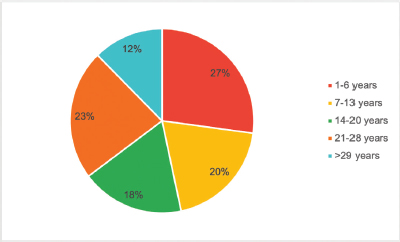
4. Analysis
4.1. Use of Digital Resources
Q8 and Q9 aimed to collect information about the types of digital resources and software most frequently used by teachers to create their educational materials (RQ1; Figure 2). As expected, most teachers reported using digital resources based on videos (196 out of 210 responses) and presentation software (188; e.g., PowerPoint and Google Slides). Interactive exercises and gamified questionnaires were the third most frequently used type of resource. The type of software employed for these activities varied, including Kahoot, Hot Potatoes, JClic, Quizlet, Baamboozle, Padlet, Flippity or H5P. In this case, 184 of the teachers surveyed reported using these tools to create teaching materials. To a lesser extent, participants also mentioned using messaging apps (24), such as WhatsApp, Telegram and Facetime; VR/AR apps (21); and non-programmer tools, such as Scratch, CoSpaces or AppInventor (18). Leaving aside other subject-specific software (9), the least frequently used resources were video games (6) and social networks (4; e.g., TikTok and Instagram). In addition, only around half of the teachers used videos or video games created by themselves and aligned to their teaching needs (Q8). For the other resources mentioned, the percentage of teachers who both used and created their own materials remained consistent, dropping significantly only for non-programmer tools (decreasing from 18 to 13 responses).
Figure 2. Teachers’ Use of Digital Resources for Teaching and Creating Teaching Resources.
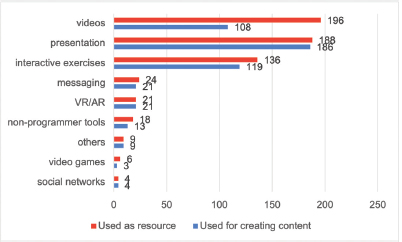
4.2. Learning Approaches
When participants were asked to identify up to three learning approaches or strategies (Q10) of greatest interest to them (RQ2), the most frequently selected were collaborative learning (149 out of 210 responses), followed by experience-based learning (97 responses), discovery learning (87) and individual learning (87). By contrast, visual learning (53 responses), contextualised learning (50), and immersive learning (44) approaches were among the least selected (see Figure 3).
Figure 3. Frequency of Demanded Teaching Approaches Across All STEAM Areas.
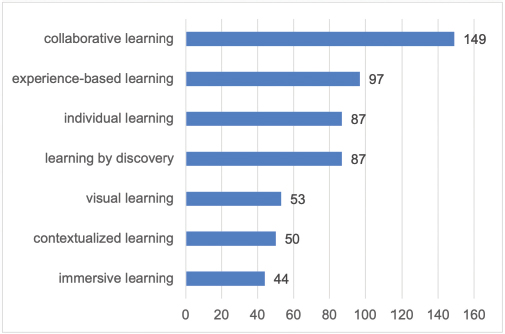
Finally, an analysis of educators’ needs across teaching areas revealed no significant differences among them (Table 3).
Table 3. The Three Most Demanded Learning Approaches Per Area.
Arts and Humanities |
Collaborative learning (25.39%), experience-based learning (16.49%) and individual learning (16.23%) |
Engineering |
Experience-based learning (30.77%), collaborative learning (23.08%) and visual learning (15.38%) |
Mathematics |
Individual learning (31.82%), collaborative learning (23.08%) and experience-based learning (18.18%) |
Science |
Collaborative learning (23.39%), experience-based learning (18.18%) and discovery learning (13.64%) |
Technology |
Collaborative learning (29.49%), experience-based learning (19.23%) and individual learning (17.95%) |
4.3. Teachers’ Needs Regarding Educational Tools
To better understand teachers’ needs and preferences for teaching and learning tools, the survey participants were asked to specify up to five types of educational tools in which they were most interested (Q11). The study found that teachers’ primary concern was to find tools that engage students in the learning process (143 out of 210 responses), followed by the need to find tools that facilitate the teaching process (111) and autonomous learning process (109), as well as the acquisition of learning content (104). These needs are clearly framed within an educational context characterised by factors like increasing diversity within classrooms (Carvalho et al., 2019), a lack of motivation among a large portion of the student population (Padilla Piernas et al., 2024) and a growing attention deficit among students (Fabiano et al., 2024). These factors reinforce the need to continuously review and adapt teaching–learning resources to align with students’ profiles and specific needs. In this context, it is not surprising that teachers are much less interested in tools that allow them to create innovative teaching and learning resources (79 responses), facilitate teacher–student interaction (74) or support student assessment (70; see Figure 4).
Figure 4. Teachers’ Needs for Educational Tools.
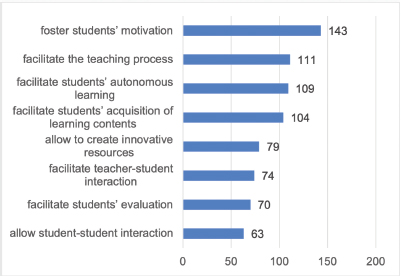
Notably, despite their interest in pedagogical approaches like collaborative learning (see Figure 3), teachers showed much less interest in tools that facilitate student–student interaction (63). Table 4 presents the three most requested tools in each area, based on an analysis of teachers’ needs.
Table 4. The Three Most Frequently Demanded Tools Per Area.
Arts and Humanities |
Tools that foster students’ motivation (20%) and facilitate the acquisition of learning content (14.65%) and the teaching process (14.46%) |
Engineering |
Tools that facilitate students’ autonomous learning (22.22%), facilitate teacher–student interactions (67%), facilitate students’ evaluation, allow student–student interaction, facilitate students’ acquisition of learning content and foster students’ motivation (11.11% each) |
Mathematics |
Tools that facilitate students’ autonomous learning (25%), foster students’ motivation (20%) and facilitate students’ evaluation (17.86%) |
Science |
Tools that foster students’ motivation (20.25%), facilitate the teaching process (17.09%) and facilitate teacher–student interaction (12.66%) |
Technology |
Tools that facilitate students’ autonomous learning (16%) and the teaching process (14%) and foster students’ motivation (13%) |
4.4. Use of Digital Devices for Teaching
The analysis of teachers’ use of digital devices in class (Q7) revealed that computers were the most frequently used tool (188 out of 210 responses), while significantly fewer reported using smartphones and tablets (70 and 52, respectively). The proportion of teachers using no electronic devices in the classroom is remarkably low (10 responses).
A more detailed examination of teachers’ profiles (e.g., by teaching area, gender and age) reveals that technology and mathematics are the areas where electronic devices are used the most, with all teachers in these fields reporting the use of at least one device. The analysis indicates, however, that computers remain the most widely used electronic device, regardless of teaching discipline (Figure 5).
Figure 5. Electronic Devices Used Per Area.
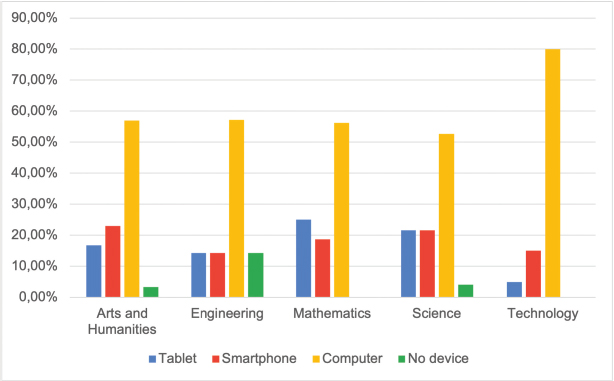
When examining factors like gender or age, the percentage of teachers using computers and smartphones with their students is slightly higher among men (60.55% and 24.77%, respectively) compared to women (58.25% and 19.9%, respectively) and, to some extent, those who did not specify their gender (40% and 60%). Individuals who did not disclose their gender (20%) and women (17.96%) tended to use tablets more frequently than men (12.84%).
Figure 6. Use of Electronic Devices According to Gender.
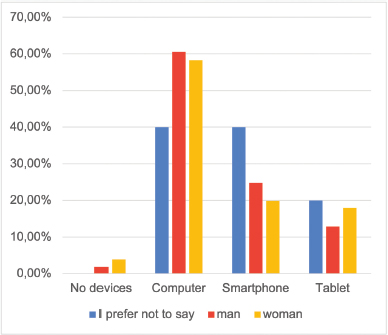
Finally, the use of electronic devices is generally much higher among younger teachers (100% among those aged 23–29) than teachers aged 30–51 years and older, where usage gradually decreases from around 97% to 95%. Although trends and preferences remain similar across all age groups, the percentage of those who use no electronic devices in the classroom increases notably with age, rising from 2.52% to 4.23%.
4.5. Teachers’ Expertise in VR and AR Technologies
When analysing teachers’ expertise (RQ3) in VR and AR technologies (Q12–Q13), less than half of the surveyed teachers (49%) considered themselves knowledgeable in this area, rating their knowledge as either very high (16%) or moderate (33%). Meanwhile, 42% admitted to having little knowledge of these technologies, and 9% reported having no knowledge at all (see Figure 7).
Figure 7. Teachers’ Knowledge of VR and AR Technologies.
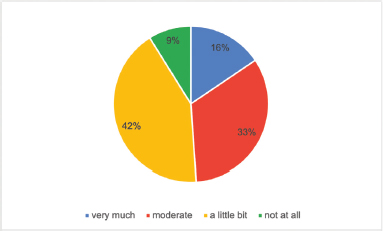
These findings are reinforced by data on teachers’ use of VR/AR in their daily lives. Only 22% of the teachers surveyed reported using VR/AR regularly, while 25% report using it rarely and 53% report never having used it. Regarding the VR/AR applications they had used, the most frequently mentioned were commercial software (e.g., Google Arts & Culture, Lens [AR] and IKEA Place) or games (Pokémon Go, Wii and Nintendo).
4.6. Teachers’ Experience with VR/AR Technologies for Teaching
An analysis of teachers’ experiences with VR/AR suggests that these technologies remain rarely used in the classroom (Q14–Q15); 86.67% of survey participants reported never having used them, 12% had used them occasionally and only 0.96% had used them very often or often (0.48% each). An analysis of participants’ responses by teaching area and age reveals that VR/AR technology is most used in fields like technology (22.58%), mathematics (22.22%) and engineering (20%) and is significantly less frequent in fields like science (15.56%) and arts and humanities (9.49%; see Figure 8).
Figure 8. Use of VR/AR Technologies in Teaching, by Field of Study.
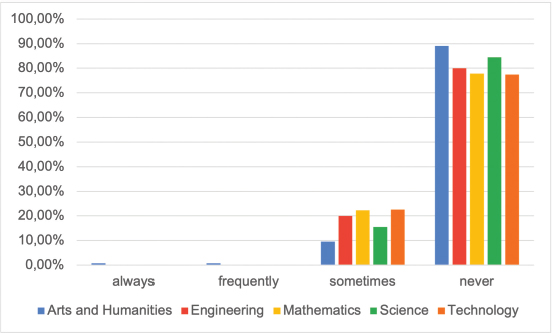
Hence, the data suggest that despite the increasing demands for digital innovation and teacher training in digital literacy (Gutiérrez-Castillo, 2021), the integration of cutting-edge technologies like VR/AR seems to take place at a much lower pace in education than in other areas of society. This is particularly noteworthy given the enormous potential of such technologies to create immersive and interactive experiences that can enhance understanding of abstract and complex concepts in fields like engineering, science and mathematics or allow the exploration of historical and cultural environments that are usually impossible to recreate in traditional classroom settings for teaching the arts and humanities (Christou et al., 2025; Jesionkowska et al., 2020).
4.6.1. Teachers’ Use of VR/AR Technologies by Age
When examining teachers’ ages, the results suggest that younger teachers (aged 23–36) are more likely to integrate VR/AR technologies (16.67% and 21.74%, respectively) into their teaching compared to senior teachers, whose usage ranged from 8.7% to 11.94%. The use of these technologies, however, was generally very low across all ages (see Figure 9).
Figure 9. Teachers’ Use of VR/AR Technologies by Age.

4.6.2. VR/AR Apps Used for Teaching
When assked about the VR/AR applications they use, some teachers mentioned using Google’s VR Tour Creator and Quest’s Cities for VR to explore different cultures. For AR, Quiver, Roar and Aurasma were cited as tools for visualising and understanding concepts, as well as for motivating students through an innovative learning approach. Many teachers, however, referenced what appeared to be non-commercial software, likely developed by universities or research institutions. In some cases, the apps were used in class to develop listening and speaking skills in foreign languages. Additionally, some teachers could not remember which software they used, suggesting that its use was sporadic. In general, the low number of responses (19 out of 210 teachers) indicate a very limited use of VR/AR applications.
4.6.3. Teachers’ Opinions and Attitudes towards VR/AR
Despite the still cautious adoption of VR/AR technologies in teaching (12.76% of the teachers surveyed), the survey data (Q17) suggest that those who had incorporated these technologies into their classes agree on their positive effects in supporting students' learning processes (RQ4). In this context, the four most frequently mentioned positive aspects were the potential to: increase students’ motivation (19 responses), visualise and assimilate content (18), promote the exploration of environments often not accessible in conventional teaching/learning environments (16), and—in the case of AR—combine the real and virtual worlds (16; Table 5). Interestingly, teachers saw less potential in VR/AR for facilitating autonomous learning and learning in general (7 and 11 responses, respectively) or allowing learners to visualise and understand abstract content (6).
Table 5. Positive Aspects of AR and VR Technologies for Teaching.
Increase students’ motivation |
19 |
Allow the visualisation and assimilation of content |
18 |
Allow the exploration of environments that are often not accessible |
16 |
Combine the real world with the virtual world |
16 |
Facilitate learning |
11 |
Facilitate autonomous learning |
7 |
Allow the visualisation and understanding of abstract content and elements |
6 |
When asked about the negative aspects of this technology (Q18), teacher participants mentioned difficulties in managing the implementation of VR/AR resources for large courses (15 responses), the lack of technological resources (12), the difficulty of its use (11) and problems in terms of software compatibility (10). Issues that raised fewer concerns were the lack of evaluation tools (7), the lack of feedback to guide students during their learning processes (5) and difficulties in implementing the VR/AR technologies without information and communications technology (ICT) support (4; see Table 6).
Table 6. Negative Aspects of VR and AR Technologies for Teaching.
Difficult to implement for large courses |
15 |
Lack of technological resources |
12 |
Not very intuitive/easy to use |
11 |
The software used is not always compatible with students’ devices |
10 |
Lack of evaluation tools |
7 |
Lack of feedback to guide students during their learning processes |
5 |
Difficult to implement without ICT support |
4 |
None |
2 |
The feedback from the teachers surveyed reflects, on the one hand, the educational and motivational potential that numerous studies have identified in VR/AR technologies to enhance learning (Akaçyir & Akaçyir, 2017; Christou et al., 2025; Jesionkowska et al., 2020; Luo et al., 2024; Parmaxi, 2020; Parmaxi & Demetriou, 2020; Romano et al., 2020) and, on the other hand, the common concerns teachers have when implementing new technologies. These concerns are primarily related to the fact that most schools still lack the physical and financial resources to implement state-of-the-art technology or provide teachers with the pedagogical and technological training for its successful integration (Jesionkowska et al., 2020; Kaplan-Rakowski et al., 2023; Romano et al., 2023).
4.6.4. Teachers’ Suggestions for the Development of VR/AR Teaching–Learning Tools
When teachers were asked to provide their feedback and suggestions for possible improvements in the VR/AR apps they had used for their teaching (Q19), the most frequently mentioned aspects were the need to ensure compatibility with multiple operating systems (e.g., Android, iPhone; 14 responses), the need to facilitate their use and functioning (13) and the availability of a wider range of resources (12). Other aspects requiring improvement were students’ feedback mechanisms (10), support for collaborative activities (10), students’ evaluations (9) and the provision of more learning content (9). One teacher noted the need to ensure that apps did not require an internet connection but instead could be used offline (Table 7). These requirements also coincide with those expressed by the learners of a case study conducted by Valero-Franco & Berns (2023).
Table 7. Suggestions to Introduce VR/AR in Education.
Improve its compatibility with other operating systems (e.g., Android, iPhone) |
14 |
Facilitate its use and functioning |
13 |
Provide more resources (e.g., audio, video) |
12 |
Provide students with feedback |
10 |
Allow collaborative activities |
10 |
Provide more learning content |
9 |
Allow students’ evaluation |
9 |
Other |
1 |
4.6.5. Teachers’ Attitudes Towards VR/AR Technologies
The survey also aimed to gain insight into teachers’ general attitudes towards VR and AR technologies (RQ5). In this sense, feedback from teachers who had never used VR/AR technologies in their teaching was especially valuable. A look at teachers’ feedback (Q20) suggests that the reasons for not having used such technologies were primarily the lack of familiarity with the technology (98 out of 210 responses), followed by the fact that teachers either did not know how to use it in their teaching (74) or simply did not know of any VR/AR apps related to their teaching subjects (65). Notably, however, fewer teachers than initially expected cited reasons like a lack of time or a fear of an increased workload. Only 30 teachers mentioned a lack of time, while another 19 expressed their reluctance to use technologies with which they were unfamiliar. Finally, seven teachers reported not identifying any added value for their teaching (see Table 8).
Table 8. Reasons for Not Using VR/AR Technologies.
I am not familiar with this kind of technology. |
98 |
I can’t see how to use it in my teaching. |
74 |
I don’t know of any VR/AR apps related to my teaching content. |
65 |
I am usually very busy and afraid of a greater workload. |
30 |
I am afraid of using technologies I am not familiar with. |
19 |
VR/AR technologies do not offer any added value for my teaching. |
7 |
4.6.6. Teachers’ Interest in Receiving Training in the Use of VR/AR
Based on the feedback given so far and with the aim of identifying teachers’ general attitudes towards VR/AR technologies (RQ6), the survey participants were asked whether they would attend a teacher training course on the topic (Q21–Q22). The results indicated a high interest in such training courses (Figure 10).
Figure 10. Reasons for and Attitudes Towards Participating in VR/AR Training Courses.
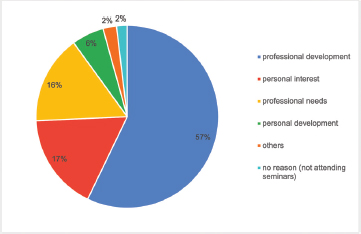
Specifically, 98% of teachers confirmed that they would attend such a course, either for professional development (57%) and needs (16%; i.e., curricula requirements or mandatory or teacher training), personal interest (17%), development (6%) or other reasons (16%). Overall, only a very small percentage of the teacher participants (2%) showed no interest in attending any training in VR/AR technologies.
Despite teachers’ generally high interest in receiving training in the use of VR/AR technologies, the data from the survey also indicate that their willingness to attend such training courses might be negatively affected by factors inherent to any course, such as excessive course hours (31.51%), high course fees (31.51%), excessive course requirements (15.43%) or the course format. In this case, teachers preferred distance learning to face-to-face courses, with 13.83% specifying that face-to-face courses could prevent them from attending a training course on VR/AR technologies. By contrast, only 3.86% considered distance learning to be a reason not to attend such courses (Figure 11).
Figure 11. Reasons for Not Being Willing to Attend VR/AR Training Courses.
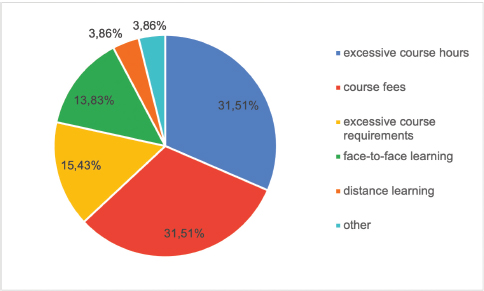
4.6.7. Teachers’ Interest in Receiving Training in the Development of VR/AR Teaching–Learning Resources
When analysing teachers’ attitudes and willingness to enrol in training courses that cover not only VR/AR technologies but also the use of EUD tools for creating personalised VR/AR teaching and learning resources (Q23; RQ6), 48% expressed strong or very strong interest in such training (33% and 15%, respectively). At the same time, however, many teachers appeared sceptical about using or reluctant to use VR/AR technologies in their teaching; 29% expressed moderate interest, followed by 17% who had little interest and 6% who had no interest.
In addition, when asked about their interest in creating VR/AR resources (Q24), most teachers (57%) confirmed feeling either motivated by the challenge (30%) or curious about it (27%). This was followed by 19% who admitted to feeling stressed or worried about the challenge. The other participants (24%) seemed less enthusiastic and curious about creating their own VR/AR resources (Figure 12).
Figure 12. Feelings About Creating Their Own VR/AR Resources.
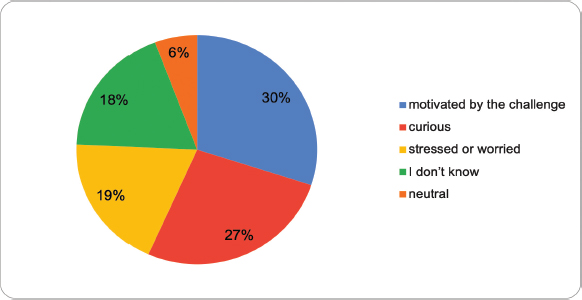
5. Findings and Discussion
This section presents the study’s findings according to the initial objectives.
5.1. Current Trends in Teachers’ Technology Usage
The study’s first objective was to gain insight into current trends in teachers’ usage of technology and their interest in concrete learning approaches and tools. The results from the analysis highlight that, despite the increasing expansion and availability of cutting-edge technologies and software applications to implement innovative and student-aligned learning materials, most teachers still rely on traditional technologies (RQ1) for both teaching and creating educational resources. Interestingly, the results from all STEAM areas indicate similar trends, with practitioners primarily using educational resources based on videos and presentation software, followed by authoring tools that enable the creation of interactive educational content, such as gamified questionnaires and exercises. Notably, other technologies, such as messaging, VR/AR apps and non-programmer tools (in addition to other subject-specific software), video games or social networks, are seldom used.
When examining the most demanded learning approaches and tools (RQ2) across all five STEAM areas, experience-based and collaborative learning consistently rank among the top three. Additionally, visual learning (engineering), discovery learning (science) and individual learning (arts and humanities and technology) were also mentioned as the most preferred approaches. Regarding teachers’ needs for learning tools, survey respondents particularly highlighted their interest in tools that support students’ autonomous learning process and actively engage them in the learning process. Both the learning approaches and tools mentioned could be effectively supported by VR and AR technologies, which enable the creation of versatile and student-centred learning environments (Gruber et al., 2024; Jesionkowska et al., 2020; Parmaxi, 2020; Parmaxi et al., 2024). However, greater pedagogical and technical support is needed to encourage teachers to adopt these technologies and fully explore their potential (Christou et al., 2025).
5.2. Teachers’ Usage of, Needs for and Attitudes towards VR/AR Technologies
The second objective was to understand teachers’ usage of, needs for and attitudes towards VR and AR technologies. The survey data indicate that these technologies are still rarely incorporated into teaching practices across all STEAM areas, with notably low adoption among senior teachers and in fields like arts and humanities. Unsurprisingly, the primary reason for this appears to be a lack of familiarity with these technologies, which prevents educators from recognising their potential to enhance the teaching–learning process (RQ3 and RQ4). Providing teachers with more pedagogical training could help them better understand the educational value of VR/AR technologies and encourage their adoption (RQ6).
A noteworthy finding from the study is the teachers’ positive attitude towards such training. Notably, they expressed a strong interest in participating in VR/AR training courses, with fear of using unfamiliar technologies being one of the least-cited reasons for their current lack of adoption (RQ5).
Still, although teachers appear willing to use ready-made VR/AR digital resources, they were significantly less interested in receiving training on educational authoring tools that would enable them to create VR/AR resources independently (RQ7). This reluctance aligns with their preference for traditional tools, such as presentation software, over more innovative alternatives for developing non-VR/AR-based digital educational content. Given this, it is not surprising that, if teachers already recognise the difficulty of creating standard digital educational content, developing materials based on a largely unfamiliar technology may seem challenging, if not intimidating. As a result, they may perceive more potential drawbacks than benefits in using these technologies to enhance the teaching–learning process. This highlights the need to design authoring tools that conceal the complexity of the technology, alleviate such concerns, and potentially increase teachers’ willingness to adopt them.
5.3. Challenges in Integrating VR/AR Technologies into the Classroom
The third objective was to identify key factors software designers should consider when developing VR/AR authoring tools to help teachers create resources aligned with their instructional needs (RQ8). The survey results, combined with our literature review and experience, highlight some significant challenges developers face in designing effective applications for this purpose.
A key priority is to ensure that the authoring tool is user-friendly and intuitive, particularly for teachers with limited technical expertise (Godwin-Jones, 2015; Parmaxi, 2020; Romano et al., 2020). Well-designed graphical user interfaces (GUIs) and prebuilt templates can enhance the non-expert user experience and streamline the development process, as demonstrated by their effective implementation in AR authoring tools, such as WebART (Liu et al., 2022) and ARCreator (Romano et al., 2020). Novel AR/VR authoring approaches, such as VR immersive authoring (Coelho et al., 2024) or generative AI-assisted authoring (Cuervo-Rosillo et al., 2024), have the potential to significantly lower the technical barrier for educators when applied to this area.
Regardless of the technique used to improve these tools’ usability, and given the wide range of requirements that can arise from different teacher needs, learner profiles, subjects and pedagogical strategies, research has consistently emphasised the importance of applying user-centred approaches to the design of authoring tools (Christou et al., 2025; Lytridis et al., 2018; Romano et al., 2020) to ensure that the real needs of practitioners are properly addressed.
Another key challenge lies in adapting standard educational procedures, such as monitoring, tracking and assessment, to these novel environments (Chamusca et al., 2023). This also presents, however, an opportunity to enhance these processes: for example, by leveraging facial biometrics to facilitate monitoring (Daza et al., 2025) or capturing more accurate learning metadata (Mota et al., 2018). The survey also highlighted both technical and user-related issues that software developers should consider. In this context, we offer the following recommendations:
•Ensure the application software is compatible with different platforms (e.g., Android and iOS) and various device versions.
•Ensure scalability to support software implementation for many students.
•Ensure that internet connectivity is not always required, allowing learning tasks to be performed both online and offline whenever possible (Pegrum, 2021).
•Ensure the authoring tool is affordable or free to encourage widespread adoption (Liu et al., 2022).
5.4. Limitations of the Study
Some limitations of this study warrant attention. The survey was conducted solely among teachers within the Spanish educational community. While it can be expected that their circumstances would resemble those of other Western countries or exhibit notable similarities with the broader European Union, considering their adherence to the same strategic framework for cooperation in education and training, it is important to acknowledge potential variations and nuances. Therefore, a larger and more diversified sample size would enhance the generalisability of the findings on teachers’ use of VR/AR technologies and EUD tools.
6. Conclusions and Future Directions
While VR/AR technologies are clearly becoming an increasing part of peoples’ daily lives, this is not the case in education, where their integration remains lacking (Christou et al., 2025; Kaplan-Rakowski et al., 2023; Parmaxi & Demetriou, 2020). The current study identified trends in teachers’ use of technologies in general, and VR/AR technology in particular, and their needs to ensure their effective integration into the teaching–learning processes. The results highlighted not only teachers’ interest in using and implementing cutting-edge technologies but also their lack of experience and expertise with such technologies and hence the need for increased training, which should include pedagogical and technical training in the use of VR/AR technologies (Hubbard, 2023) and EUD tools in particular to help teachers create teaching–learning resources that are innovative while at the same time aligned with students’ learning needs and learning preferences. The results also emphasise the need for greater collaboration among software developers, teachers and learners to ensure that the learning tools align with the needs of both educators and students, making the teaching–learning process more effective and efficient, as well as dynamic and student-centred.
These results could therefore lay the groundwork for a broader research project aimed at defining important guidelines and principles to help software developers design VR/AR technologies and authoring tools aligned with teachers’ needs and help teachers implement such technologies in their teaching syllabus.
Future research could include qualitative data—e.g., interviews, case studies or focus groups—to delve deeper into educators’ experiences and the nuances of integrating VR/AR technologies, complementing the quantitative findings and providing a clearer picture of their practical challenges and success factors.
Acknowledgements
This paper is part of the R&D project PID2023-149674OB-I00, funded by MICIU/AEI/10.13039/501100011033 and ERDF, UE and EU NextGenerationEU/PRTR, Sense2makeSense (PID2019-109388GB-I00) funded by the Spanish Research Agency (Agencia Estatal de Investigación), ARIDLL funded by the Erasmus+ KA2 programs (2022-1-NO01-KA220-HED-000088034). The authors also gratefully acknowledge the support and feedback provided by all teachers, external collaborators and validators who participated in the current study and survey.
Authors’ contribution
Anke Berns: Conceptualisation, Research, Methodology, Writing - original draft, Writing - proofreading and editing
Telmo Zarraonandia: Conceptualisation, Data curation, Formal analysis, Research, Methodology, Writing - original draft, Writing - proofreading and editing
Teresa Onorati: Conceptualisation, Data curation, Writing - proofreading and editing
Paloma Díaz: Conceptualisation, Methodology, Supervision, Writing - proofreading and editing
Juan-Manuel Dodero: Validation, Writing - proofreading and editing
References
Akçayır, M., & Akçayır, G. (2017). Advantages and challenges associated with augmented reality for education: A systematic review of the literature. Educational Research Review, 20, 1-11. https://doi.org/10.1016/j.edurev.2016.11.002
Alex, G., & Alaa, H. (2024). Design and Development of an Authoring Tool for XR-Based Engineering Training. In 2024 IEEE International Conference on Engineering, Technology, and Innovation (ICE/ITMC) (Funchal, Portugal, 24-28 June 2024). https://doi.org/10.1109/ICE/ITMC61926.2024.10794395
Berns, A., & Reyes-Sánchez, S. (2021). Una revisión de apps de realidad virtual para el aprendizaje de idiomas. RIED-Revista Iberoamericana de Educación a Distancia, 24(1), 159–177. https://doi.org/10.5944/ried.24.1.27486.
Carvalho, M., Azevedo, H., Vale, C., & Fonseca, H. (2019). Diversity, inclusion, and education: Challenges in perspective. In L. Gómez Chova, A. López Martínez, & I. Candel Torres (Eds.), EDULEARN19 Proceedings (pp. 8157–8162). IATED. https://doi.org/10.21125/edulearn.2019.2003
Chamusca, I. L., Ferreira, C. V., Murari, T. B., Apolinario, A. L., & Winkler, I. (2023). Towards sustainable virtual reality: Gathering design guidelines for intuitive authoring tools. Sustainability, 15(4), 2924. https://doi.org/10.3390/su15042924
Christou, E., Parmaxi, A., & Christoforou, M. (2025). Implementation and application of extended reality in foreign language education for specific purposes: A systematic literature review. Universal Access in the Information Society. https://doi.org/10.1007/s10209-025-01191-w
Coelho, H., Monteiro, P., Gonçalves, G., Melo, M., & Bessa, M. (2024). Immersive creation of virtual reality training experiences. IEEE Access, 12, 85773–85782. https://doi.org/10.1109/ACCESS.2024.3413337
Cuervo-Rosillo, R., Zarraonandia, T., & Díaz, P. (2024). Using generative AI to support non-experts in the creation of immersive experiences. In C. Conati, I. Torre, & G. Volpe (Eds.), AVI '24: Proceedings of the 2024 International Conference on Advanced Visual Interfaces (Article 82). ACM. https://doi.org/10.1145/3656650.3656733
Daza, R., Shengkai, L., Morales, A., Fierrez, J., & Nagao, K. (2025). SMARTe-VR: Student Monitoring and Adaptive Response Technology for e-learning in Virtual Reality. arXiv preprint, arXiv:2501.10977. https://arxiv.org/abs/2501.10977
Dengel, A., Iqbal, M. Z., Grafe, S., & Mangina, E. (2022). A review on augmented reality authoring toolkits for education. Frontiers in Virtual Reality, 3, 798032. https://doi.org/10.3389/frvir.2022.798032
Dunleavy, M., & Dede, C. (2014). Augmented reality teaching and learning. In J. Spector, M. Merrill, J. Elen, & M. Bishop, Handbook of research on educational communications and technology (pp.735-745). Springer. https://doi.org/10.1007/978-1-4614-3185-5_59
Fabiano, G. A., Lupas, K., Merrill, B. M., Schatz, N. K., Piscitello, J., Robertson, E. L., & Pelham, W. E., Jr. (2024). Reconceptualizing the approach to supporting students with attention-deficit/hyperactivity disorder in school settings. Journal of School Psychology, 104, 101309. https://doi.org/10.1016/j.jsp.2024.101309
Godwin-Jones, R. (2015). The evolving roles of language teachers: Trained coders, local researchers, global citizens. Language Learning & Technology, 19(1), 10–22.
González-Izard, S., Juanes-Méndez, J. A., García-Peñalvo, F. J., Gonçalvez-Estella, J. M., Sánchez-Ledesma, M. J., & Ruisoto-Palomera, P. (2018). Virtual Reality as an Educational and Training Tool for Medicine. Journal of Medical Systems, 42, 50. https://doi.org/10.1007/s10916-018-0900-2
Gruber, A., Berns, A., & Fominykh, M. (2024). Enhancing language teaching with augmented reality: Insights from the ARIDLL project. In Y. Choubsaz, P. Díez-Arcón, A. Gimeno-Sanz, J. Hriňák, X. Liashuk, S. Pokrivčáková, & H. Vančová (Eds.), CALL for Humanity - EUROCALL 2024 Short Papers (pp. 155-162). https://doi.org/10.4995/EuroCALL2024.2024.19056
Gutiérrez-Castillo, J. J. (2021). Presentation: Digital innovation in education [Innovación digital en educación]. EDMETIC, 10(1), I–III. https://doi.org/10.21071/edmetic.v10i1.1317912].
Hubbard, P. (2023). Emerging technologies and language learning: Mining the past to transform the future. Journal of China Computer-Assisted Language Learning, 3(2), 239–257. https://doi.org/10.1515/jccall-2023-0003
Ibáñez, M. B., & Delgado-Kloos, C. (2018). Augmented reality for STEM learning: A systematic review. Computers & Education, 123, 109–123. https://doi.org/10.1016/j.compedu.2018.05.002
Jesionkowska, J., Wild, F., & Deval, Y. (2020). Active learning augmented reality for STEAM education—A case study. Education Sciences, 10(8), 198. https://doi.org/10.3390/educsci10080198
Kaplan-Rakowski, R., Papin, K., & Hartwick, P. (2023). Language teachers’ perceptions and use of extended reality. CALICO Journal, 40(1), 1–23. https://doi.org/10.2139/ssrn.4096263
Kim, J., Miller, J., Wang, K., Dorneich, M. C., Winer, E., & Brown, L. J. (2024). Empowering instructors: Augmented reality authoring toolkit for aviation weather education. IEEE Transactions on Learning Technologies, 17, 2195–2206. https://doi.org/10.1109/TLT.2024.3486630
Liu, E., Cai, S., Liu, Z., & Liu, C. (2022). WebART: Web-based augmented reality learning resources authoring tool and its user experience study among teachers. IEEE Transactions on Learning Technologies, 16(1), 53–65. https://doi.org/10.1109/TLT.2022.3214854
Luo, S., Zou, D., & Kohnke, L. (2024). A systematic review of research on xReality (XR) in the English classroom: Trends, research areas, benefits, and challenges. Computers & Education: X Reality, 4, 100049. https://doi.org/10.1016/j.cexr.2023.100049
Lytridis, C., Tsinakos, A., & Kazanidis, I. (2018). ARTutor— An augmented reality platform for interactive distance learning. Education Sciences, 8(1), 6. https://doi.org/10.3390/educsci8010006
Mota, J. M., Ruiz-Rube, I., Dodero, J. M., & Arnedillo-Sánchez, I. (2018). Augmented reality mobile app development for all. Computers & Electrical Engineering, 65, 250–260. https://doi.org/10.1016/j.compeleceng.2017.08.025
Nistor, A., Gras-Velazquez, A., Billon, N., & Mihai, G. (2018). Science, technology, engineering and mathematics education practices in Europe. Scientix Observatory Report. European Schoolnet. https://d66z.short.gy/oyn5AW
Padilla Piernas, J. M., Parra Meroño, M. C., & Flores Asenjo, M. P. (2024). Virtual escape rooms: A gamification tool to enhance motivation in distance education [Escape Rooms virtuales: una herramienta de gamificación para potenciar la motivación en la educación a distancia]. RIED-Revista Iberoamericana de Educación a Distancia, 27(1), 61–85. https://doi.org/10.5944/ried.27.1.37685
Parmaxi, A. (2020). Virtual reality in language learning: A systematic review and implications for research and practice. Interactive Learning Environments, 31(1), 172–184. https://doi.org/10.1080/10494820.2020.1765392
Parmaxi, A., Berns, A., Adinolfi, L., Gruber, A., Fominykh, M., Voreopoulou, A., Wild, F., Vassiliou, P., Christou, E., Valero‐Franco, C., Aagaard, T., & Hadjistassou, S. (2024). Augmented Reality in Language Learning: Practical Implications for Researchers and Practitioners. In P. Zaphiris & A. Ioannou (Eds.), Learning and Collaboration Technologies. 11th International Conference, LCT 2024, Held as Part of the 26th HCI International Conference, HCII 2024, Washington, DC, USA, June 29–July 4, 2024, Proceedings, Part III (pp. 138-154). Springer Nature Switzerland. https://doi.org/10.1007/978-3-031-61691-4_10
Parmaxi, A., & Demetriou, A. A. (2020). Augmented reality in language learning: A state‐of‐the‐art review of 2014–2019. Journal of Computer Assisted Learning, 36(6), 861–875. https://doi.org/10.1111/jcal.12486
Pegrum, M. (2021). Augmented reality learning: Education in real-world contexts. In T. Beaven & F. Rosell Aguilar (Eds.), Innovative language pedagogy report (pp. 115–120). Research-publishing.net. https://doi.org/10.14705/rpnet.2021.50.1245
Perifanou, M., Economides, A. A., & Nikou, S. A. (2023). Teachers’ views on integrating augmented reality in education: Needs, opportunities, challenges and recommendations. Future Internet, 15(1), 20. https://doi.org/10.3390/fi15010020
Özçelik, N. P., Eksi, G., & Baturay, M. H. (2022). Augmented reality (AR) in language learning: A principled review of 2017–2021. Participatory Educational Research, 9(4), 131–152. https://doi.org/10.17275/per.22.83.9.4
Quan, C. G. (2017). The pros and cons of requiring SCRATCH in the applied linguistics classroom: Student and student-teachers’ reactions and recommendations, instructor’s observations for EISTA 2017. Proceedings of the 11th International Multi-Conference on Society, Cybernetics and Informatics (pp. 87–92). Curran Associates.
Rajaram, S., & Nebeling, M. (2022). Paper trail: An immersive authoring system for augmented reality instructional experiences. In S. Barbosa, C. Lampe, & C. Appert (Eds.), Proceedings of the 2022 CHI Conference on Human Factors in Computing Systems (pp. 1–16). ACM. https://doi.org/10.1145/3491102.3517486
Romano, M., Díaz, P., & Aedo, I. (2020). Empowering teachers to create augmented reality experiences: The effects on the educational experience. Interactive Learning Environments, 31(3), 1546–1563. https://doi.org/10.1080/10494820.2020.1851727
Romano, M., Frolli, A., Aloisio, A., Russello, C., Rega, A., Cerciello, F., & Bisogni, F. (2023). Exploring the potential of immersive virtual reality in Italian schools: A practical workshop with high school teachers. Multimodal Technologies and Interaction 7, 111. https://doi.org/10.3390/mti7120111
Valero-Franco, C., & Berns, A. (2023). A virtual reality app created with CoSpaces: Student perceptions and attitudes. In M. Bowdon, K. Yee, & W. Dorner, Ethical Considerations of Virtual Reality in the College Classroom: Cross-Disciplinary Case Studies of Immersive Technology Implementation (pp.164-179). Routledge. https://doi.org/10.4324/9781003329718
Yigitbas, E., Klauke, J., Gottschalk, S., & Engels, G. (2023). End-user development for interactive web-based virtual reality scenes. Journal of Computer Languages, 74, 101187. https://doi.org/10.1016/j.cola.2022.101187
Appendix
Teachers’ Questionnaire
1. Gender |
Man Woman Other I prefer not to say |
2. Age |
23–29 30–36 37–43 44–50 51 |
3. Country in which you are teaching |
Spain Other |
4. Years of teaching experience |
1–6 years 7–13 years 14–20 years 21–18 years > 29 years |
5. Subjects you teach |
Foreign language teaching History History of art Archaeology Mathematics Other |
6. Level of education you teach |
Primary education Secondary education University Other |
7. Which DEVICES do you use regularly with your students in class? |
Smartphone Tablet Computer I don’t use any electronic devices. |
8. Which digital RESOURCES do you use or have you used FOR your TEACHING? |
None PowerPoint/Google slides, etc. Videos Video games Kahoot TikTok YouTube WhatsApp, Telegram, etc. Scratch, AppInventor, CoSpaces, ARTutor, H5P, etc. OpenSim and SecondLife VR/AR apps |
9. Which digital TOOLS do you use or have you used TO CREATE your teaching resources? |
None PowerPoint, Google slides, etc. Videos Video games Kahoot TikTok YouTube WhatsApp, Telegram, etc. Scratch, AppInventor and CoSpaces OpenSim and SecondLife VR/AR apps |
10. I am INTERESTED in tools that facilitate … (Indicate up to 3!) |
Individual learning Collaborative learning Contextualised learning Experience-based learning by discovery Immersive learning Visual learning |
11. I am INTERESTED in tools that … (Indicate the most important ones!) |
Facilitate the teaching process Allow the creation of innovative resources Facilitate teacher–student interaction Facilitate students’ evaluation Allow student–student interaction Facilitate students’ acquisition of learning content Facilitate students’ autonomous learning Foster students’ motivation |
12. Have you HEARD or READ about VR and AR? |
Not at all A little bit Moderate Enough Very much |
13. Have you ever USED a VR/AR app in your daily life? |
Not at all A little bit Sometimes Enough Regularly |
14. If yes, please indicate which VR/AR apps you have used. |
Wii or Nintendo (VR) Google Arts & Culture (VR) IKEA place (VR) Lens (AR) Pokémon Go (AR) I don't remember its name … |
15. Do you use AR/VR apps for your teaching? |
Never Sometimes Often Very often Always |
16. Please indicate which APPs (name and type of app) and for what TEACHING PURPOSES. |
Open-ended question |
17. What were the POSITIVE aspects of the app/s used for your TEACHING? |
Combine the real world with the virtual world Facilitate learning Allow visualisation and assimilation of contents Allow visualisation and understanding of abstract contents and elements Allow exploration of environments that are often not accessible Increase students’ motivation Facilitate autonomous learning None |
18. What were the NEGATIVE aspects of the app/s? |
Not very intuitive Not very easy to use The software used was not always compatible with students' devices Lack of technological resources Difficult to implement without ICT support Difficult to implement in large courses Lack of feedback to guide students during their learning process Lack of evaluation tools None |
19. How could the app be IMPROVED? |
Facilitate its use and functioning Improve its compatibility with other operating systems (Android, iPhone, etc.) Provide more resources (audio, video, etc.) Provide more learning content Provide students with feedback Allow students’ evaluation Allow collaborative activities None |
20. Please indicate why you haven’t used any VR/AR app. Mark all reasons applicable! |
It does not add any value to my teaching. I can’t see how to use it in my teaching. I am not familiar with this kind of technology. I am afraid of using technologies I am not familiar with. I don’t know any VR/AR apps related to my teaching content. I am very busy, and I am afraid of a greater workload. |
21. For which reason WOULD you attend training on VR/AR? Indicate the MOST IMPORTANT one! |
Professional development Professional needs Personal development Personal interest No reason (not attending seminars) Other |
22. For which reasons WOULDN'T you attend training on VR/AR? |
Excessive course hours Excessive course requirements Course fees Distance learning Face-to-face learning |
23. Are you INTERESTED in receiving TRAINING in the USE of VR/AR tools to create your teaching materials? |
Not at all A little Moderate Enough Very |
24. How would you feel about creating VR/AR resources? |
Stressed or worried Motivated by the challenge Curious Neutral I don’t know |
_______________________________
(*) Autor de correspondencia / Corresponding author